The role of team structures in social integration in swiss football clubs: a multilevel analysis
IF 1
Q2 HOSPITALITY, LEISURE, SPORT & TOURISM
引用次数: 0
Abstract
Abstract Sports clubs may be an ideal setting for social integration for people from different backgrounds. Using heuristic multilevel models, prior studies linked the individual characteristics of the members with social structures at the club context (e.g. club goals) to explain social integration. However, due the organisation of sport activities in teams, another social context with distinct social structures (e.g. team culture) exists within clubs that is likely relevant for social integration as well. Based on data from 1415 members in 140 teams of 42 Swiss football clubs, this study analyses social integration in the dimension of identification in a three-level multilevel model that is the first to include the team context as a level of analysis. The results revealed that teams differ considerably in the social integration of their members. Besides individual factors (e.g. education level, membership duration), a team culture of social togetherness and especially a pronounced team sociability are relevant for identification. Cross-level interactions showed that these factors play a role for members independent of their migration background. Yet, additional positive effects exist for members new to the club. Based on these results, sports club researchers should consider including the team level in multilevel analyses.瑞士足球俱乐部的团队结构在社会整合中的作用:一个多层次的分析
摘要体育俱乐部可能是来自不同背景的人融入社会的理想场所。使用启发式多层次模型,先前的研究将成员的个人特征与俱乐部背景下的社会结构(如俱乐部目标)联系起来,以解释社会融合。然而,由于团队中体育活动的组织,俱乐部中存在另一种具有不同社会结构的社会背景(如团队文化),这可能也与社会融合有关。基于来自42家瑞士足球俱乐部140支球队的1415名成员的数据,本研究在三级多层次模型中分析了身份认同维度的社会融合,该模型首次将球队背景纳入分析水平。结果显示,团队成员的社会融合程度差异很大。除了个人因素(如教育水平、成员持续时间)外,社交团结的团队文化,尤其是明显的团队社交能力,也与身份认同有关。跨层面的互动表明,这些因素对成员的作用与他们的移民背景无关。然而,对于新加入俱乐部的会员来说,还有其他积极的影响。基于这些结果,体育俱乐部的研究人员应该考虑将团队水平纳入多层次分析。
本文章由计算机程序翻译,如有差异,请以英文原文为准。
求助全文
约1分钟内获得全文
求助全文
来源期刊

European Journal for Sport and Society
HOSPITALITY, LEISURE, SPORT & TOURISM-
CiteScore
3.30
自引率
4.20%
发文量
17
 求助内容:
求助内容: 应助结果提醒方式:
应助结果提醒方式:


